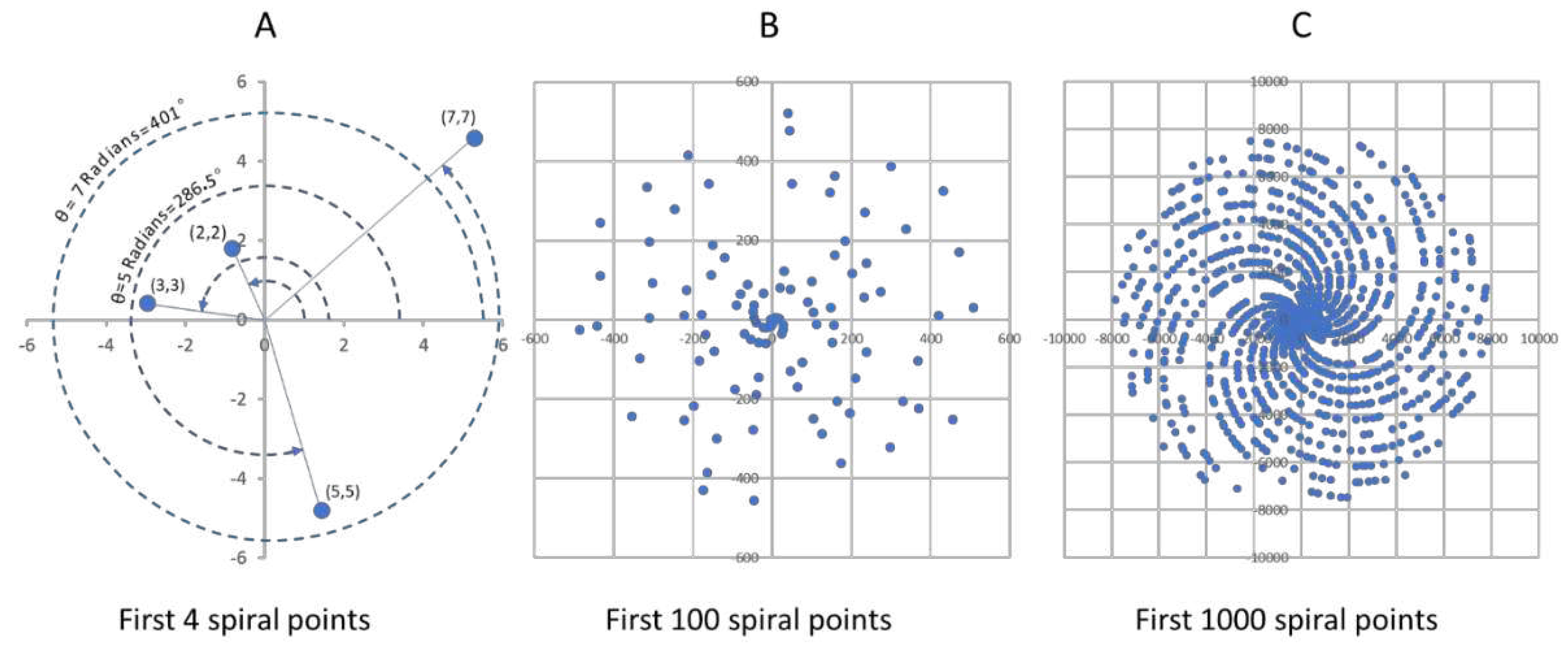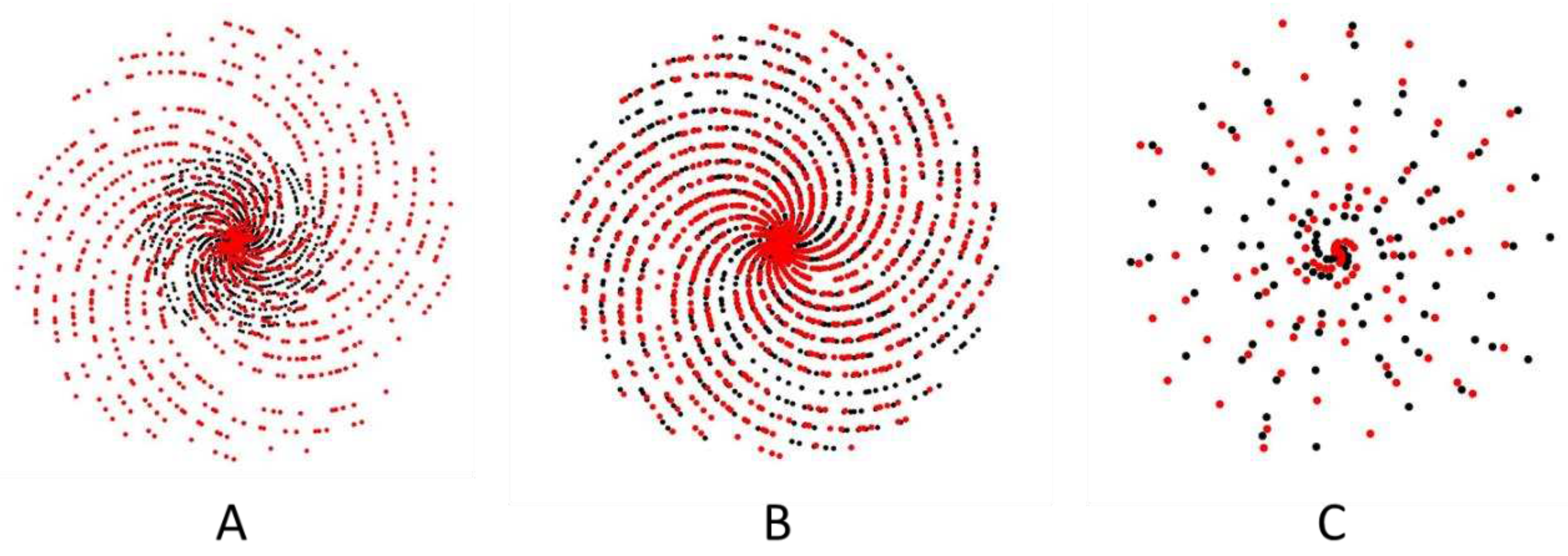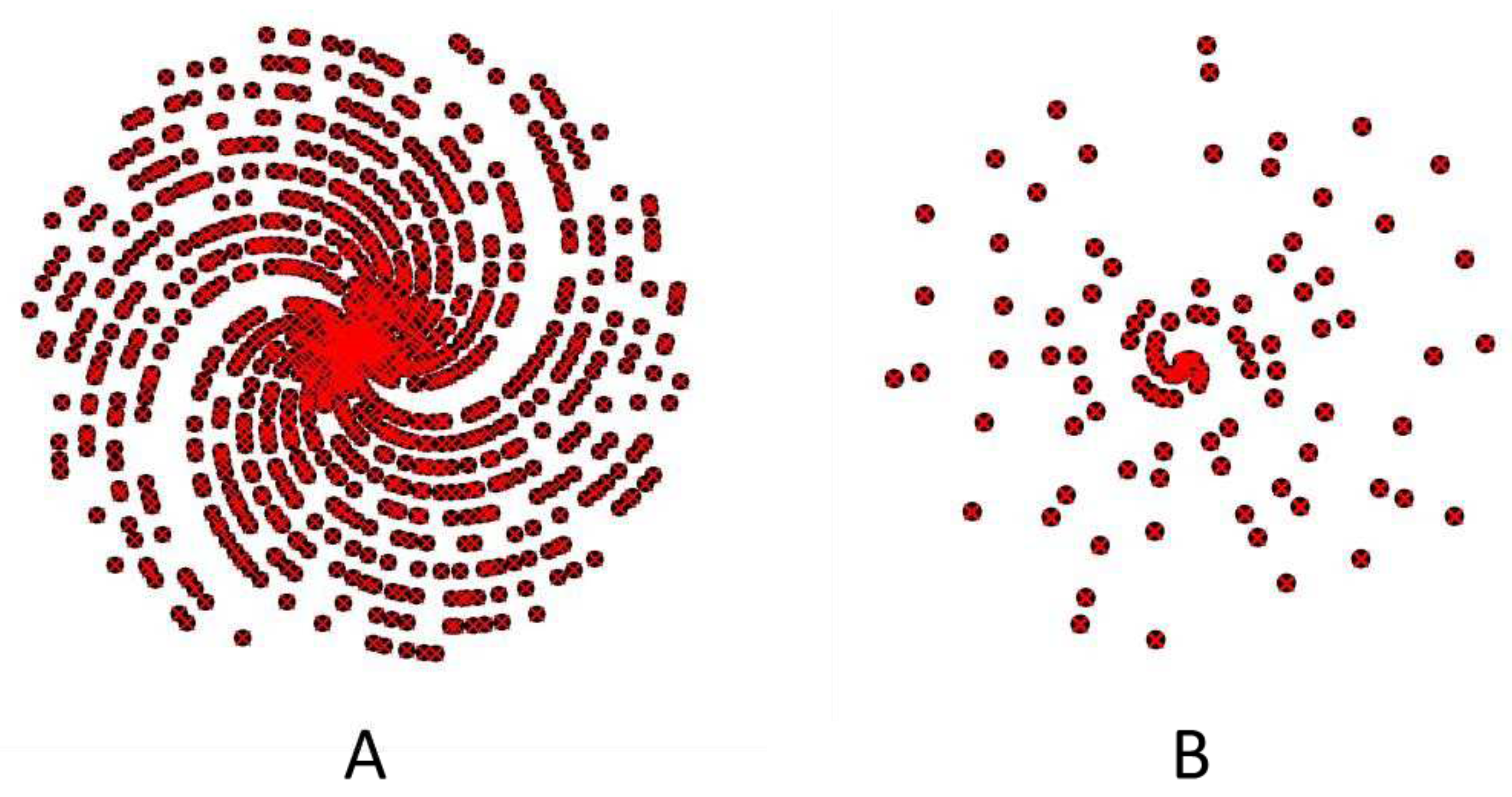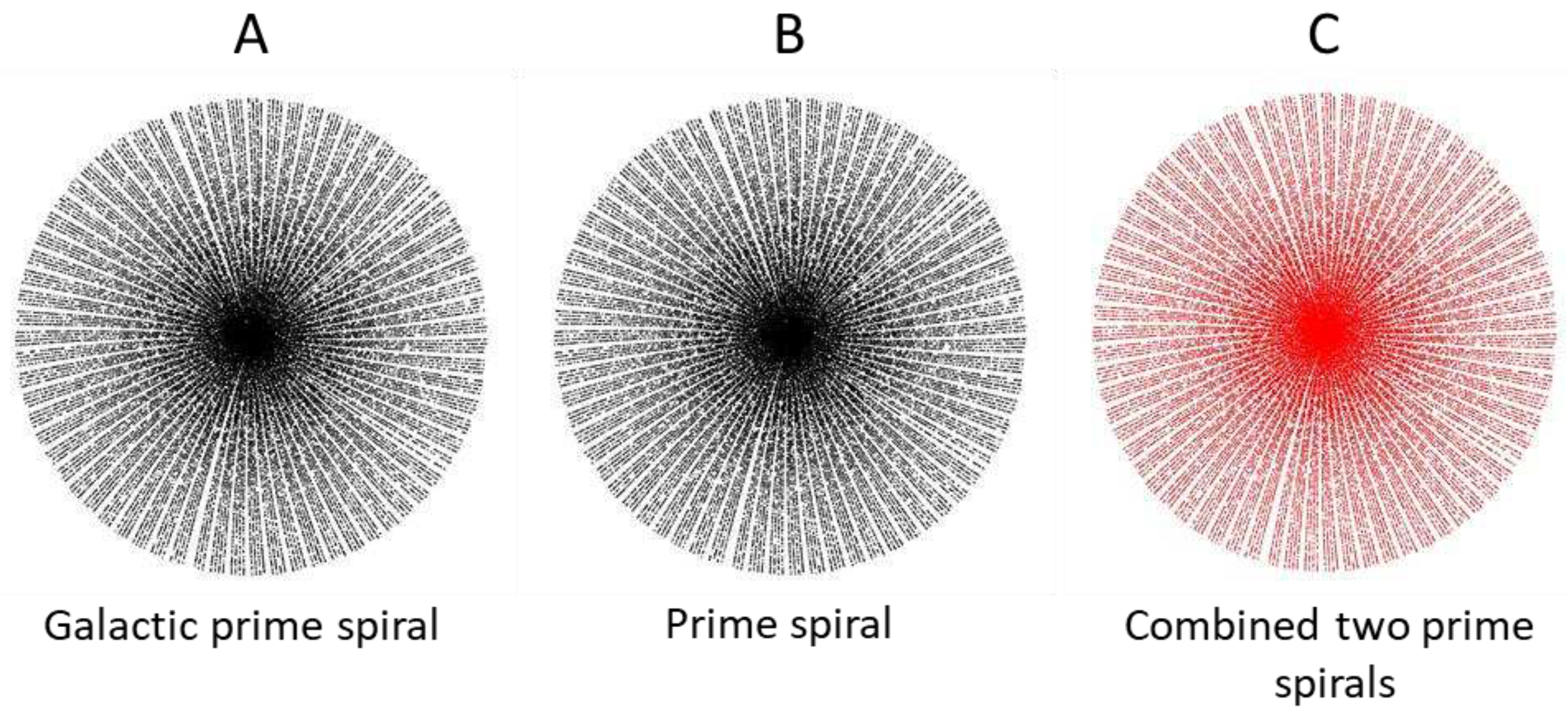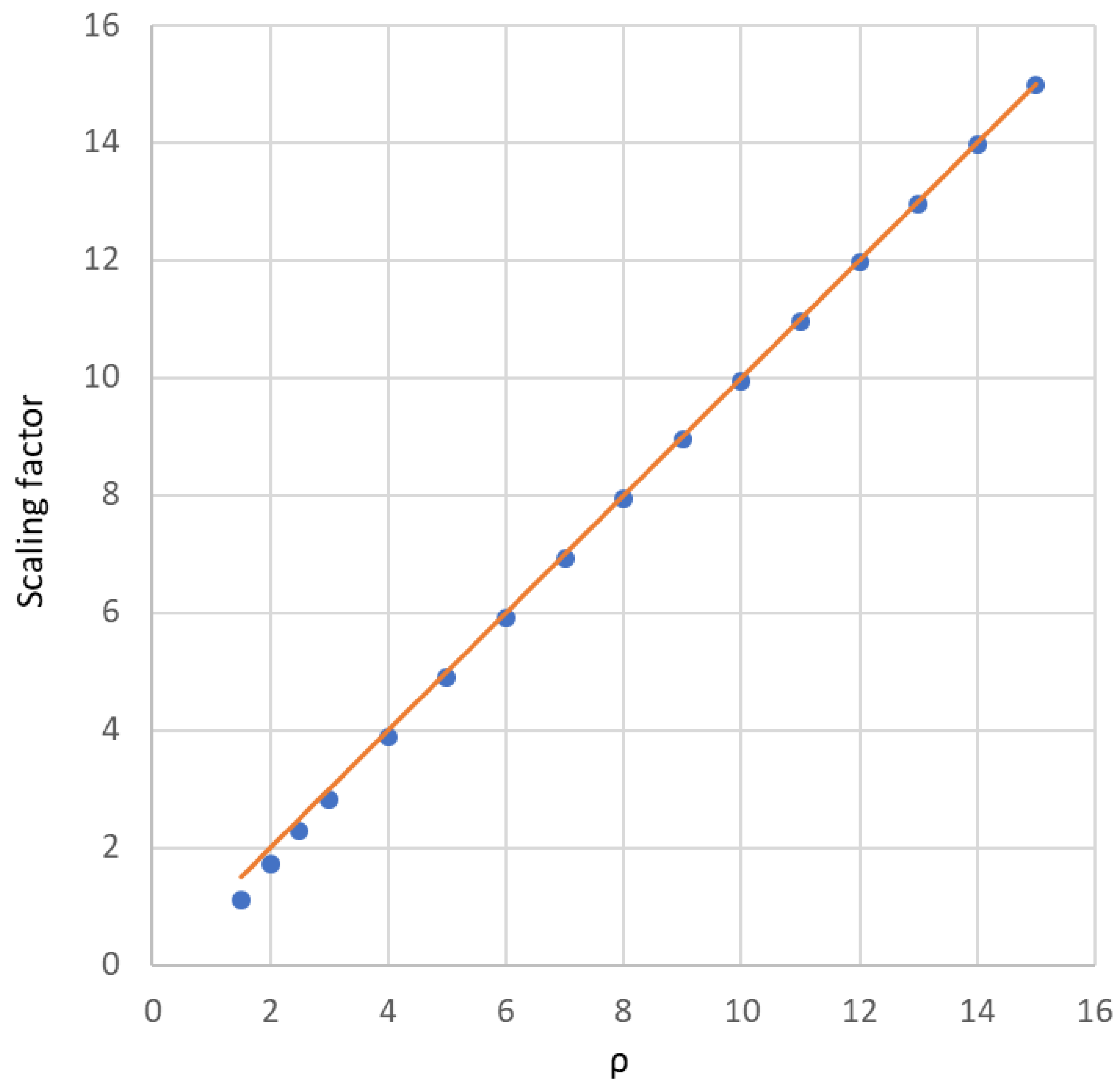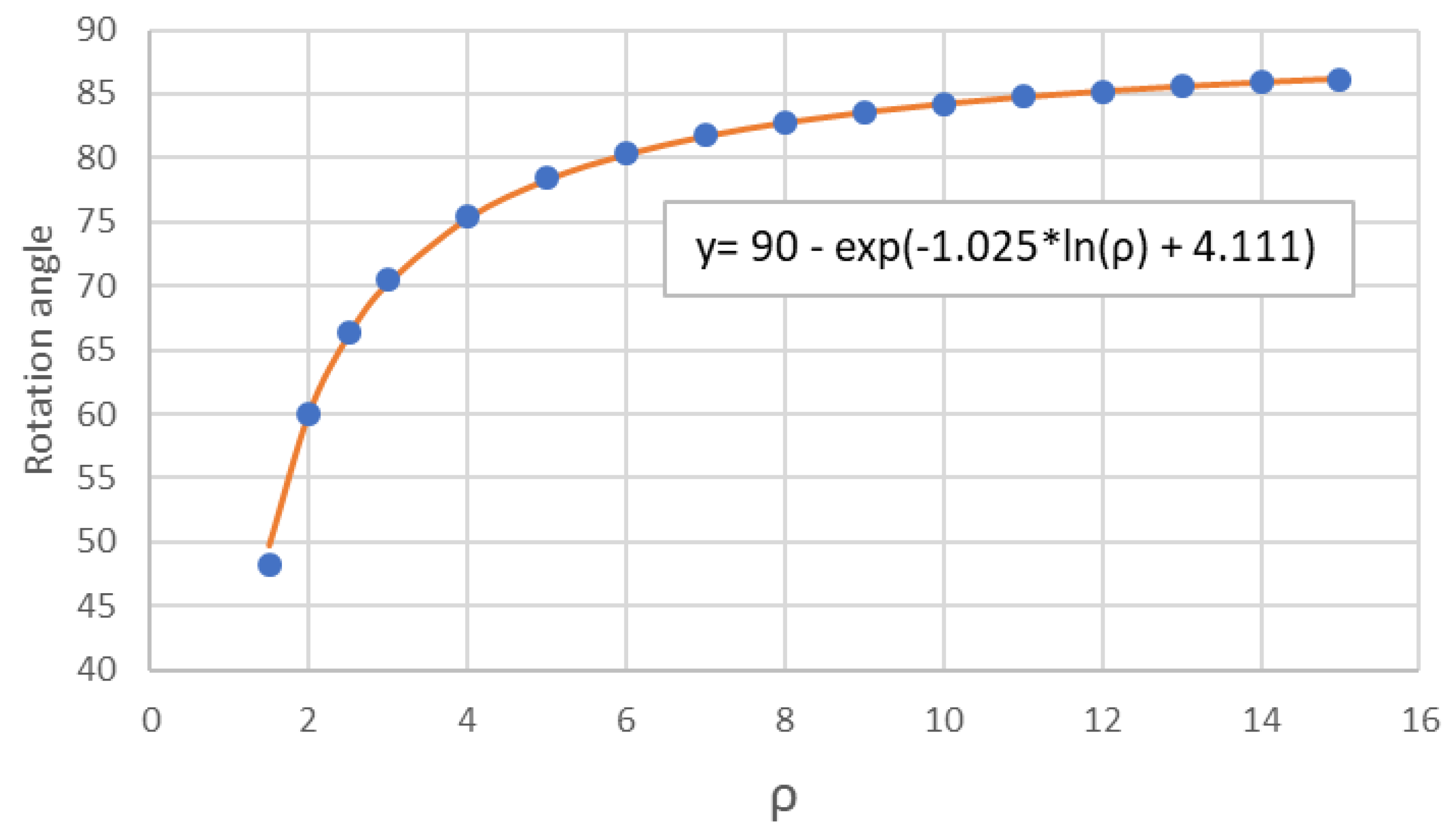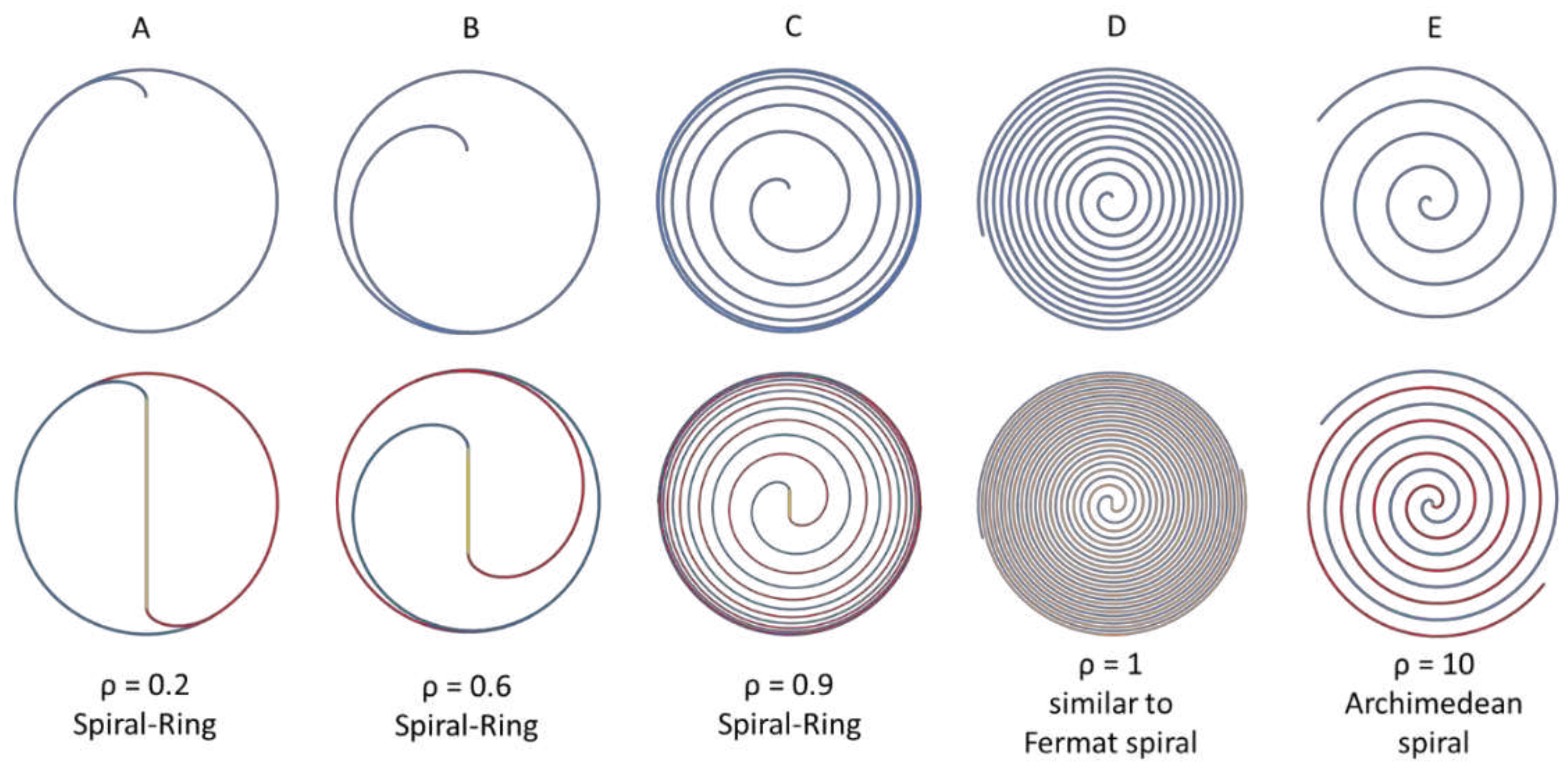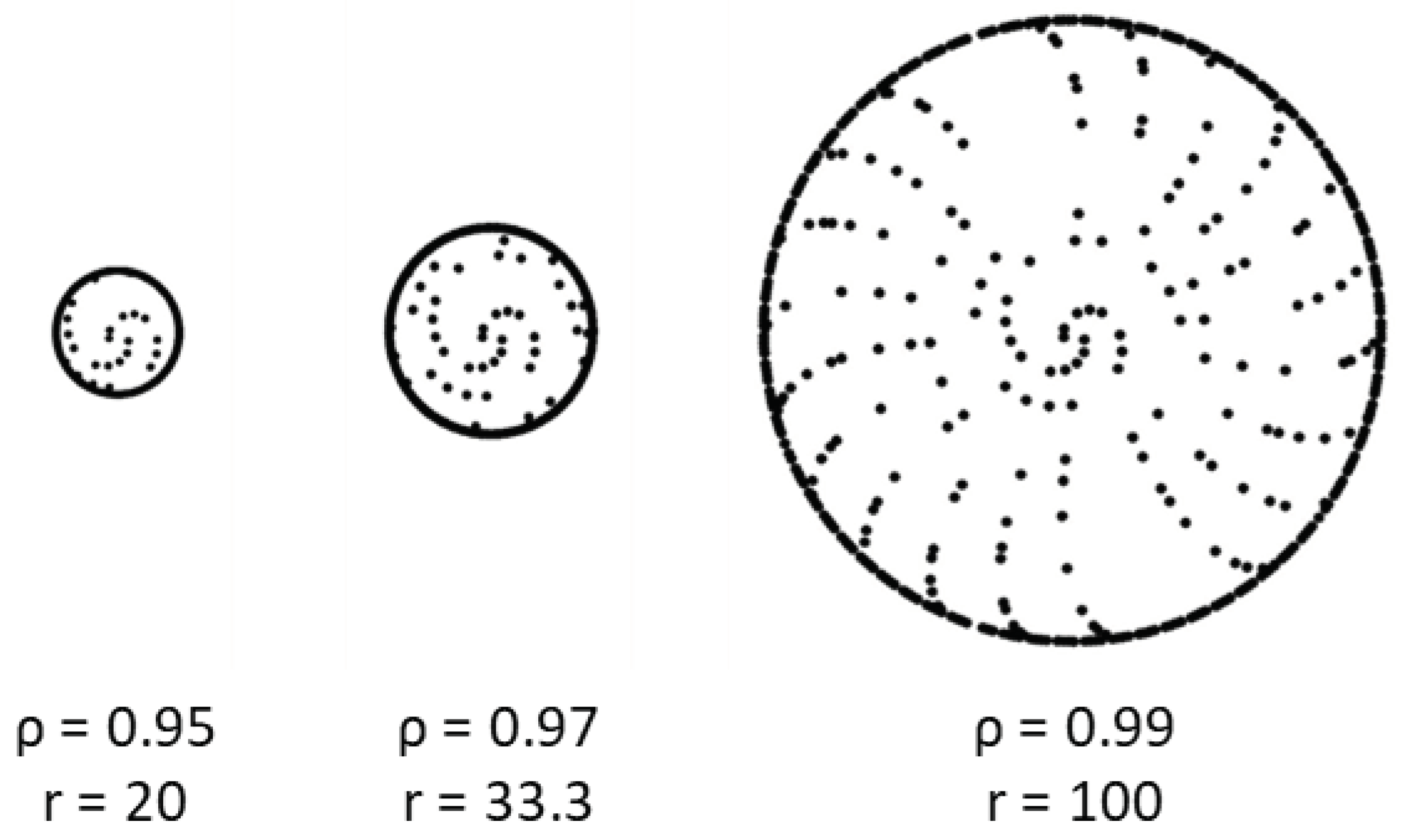X-matter plays a pivotal role in the ROTASE model, enhancing the rate of new star formation within the galaxy. The precise characterization of X-matter remains an open question, prompting speculation about whether it manifests as a particle, an unidentified physical field, or another elusive entity yet to be defined and subject to speculation.
For readers unfamiliar with the intricacies of the galactic spiral equations, gaining insight into the mechanics of spiral formation in the ROTASE model proves beneficial. This understanding allows one to discern the distinctions in the spiral-forming processes between the galactic spirals discussed in this study and the more conventional prime spirals.
2.2. The formation of the galactic spiral
In contrast to the straightforward formation of the prime spiral, the genesis of the galactic spiral within the ROTASE model is notably intricate. The underlying galactic spiral equations trace their origins to the motion of X-matter, a substance emitted from the galactic center and dragged by the galactic matter with a flat rotation.
Figure 2 provides a visual representation of the intricate process involved in the formation and calculation of spiral arms within the ROTASE model. Interested readers can delve into the details of the ROTASE model and the derivation of galactic spiral equations in the references [
2,
6]. For an alternative conceptualization, readers may also refer to a similar model where boats initially anchor at a central round island, sequentially navigating across a circular river, employing the same mathematical mechanism to derive galactic spiral equations [
7].
Assuming the galactic bar is aligned along the Y-axis and rotates clockwise, the emission of X-matter originates from the galactic center, traverses the galactic bar, and exits at point A (12 o'clock position). Subsequently, the X-matter moves freely, dragged by the rotational dynamics of galactic matter, tracing the trajectory outlined by the white dashed curve and arriving at point B. At any given point B(x, y), when the X-matter undergoes a minimal displacement "ds" over an infinitesimally short time "dt," the corresponding travel distances in the X-axis direction ("dx") and the Y-axis direction ("dy") can be calculated through the following differential equations:
Where, Vr is the galactic matter rotation velocity; Ve is the X-matter emission velocity; α denotes the angle of the distance r of the X-matter at the point B(x, y) with respect to the Y-axis.
And
The initial values of x and y are set as:
Where R is the rotation radius of the bar, or the half length of the galactic bar. The angular rotation velocity of the galactic bar is given by:
The rotation angle θ of the bar is:
Equation (6) allows us to substitute "dt" in Equation (2) with "dθ":
In other words, the galactic bar rotation angle θ serves as a time reference, akin to an old mechanical clock where 90 degrees of minute hand rotation equals 15 minutes. Equation (2) can thus be rewritten as:
Where,
The differential equations (8) can be solved within the polar coordinate system, yielding four solutions across three distinct cases, as detailed in the references [
2]. To compute the trajectory of X-matter movement along the white dashed line in
Figure 2, from point A(0, R) to point B(x, y), the equations (8) can be effortlessly implemented in a simple computer program.
However, the formation of the spiral arms, induced by the X-matter, is a progressive physical event that evolves over time. To establish a temporal reference, we adopt the current galactic bar as the "zero" time in the ROTASE model, signifying the present. Consequently, all spiral arms are considered to have formed in the past.
Referring to
Figure 2, when the galactic bar was positioned at point C in the past at an angle θ relative to the current bar along the Y-axis, X-matter emitted at C will travel to position D(x', y'). This movement follows the black dashed curve at time "t," during which the bar rotates by an angle θ relative to its current position along the Y-axis. The coordinates of D(x', y') represent a mathematical backward rotation by θ from the position B(x, y).
The mathematical expressions for this backward rotation are given by:
Plotting (x', y') generates one spiral arm of the galaxy. However, since spiral galaxies typically exhibit two spiral arms with perfect central symmetry, the other arm can be generated by considering symmetry (-x', -y').
Upon careful consideration of the above analysis, it becomes evident that the angle θ in the differential galactic spiral equations (8) represents "time," not the spiral winding angle. The actual winding angle is denoted as β and defined by:
Here, θ serves as an independent variable, while α depends on the time "θ" and the velocity of X-matter emission, Ve. This distinction is crucial, leading to the conclusion that the galactic prime spirals, generated by prime numbers as input variables, are not inherently related to the prime spiral.
Returning to the discussion of the galactic prime spiral and the prime spiral, for the previously calculated galactic prime spiral with ρ = 2.5 and R = 1.
Figure 3A presents the first 1000 points (red dots) of the galactic prime spiral and the first 1000 points (black dots) of the prime spiral, plotted on the same scale. The noticeable size difference—2.29 times for the galactic prime spiral compared to the prime spiral—initially provides no apparent indication of a potential match. However,
Figure 3B scales down the galactic prime spiral by 0.4363 to precisely match the size of the prime spiral, achieving equality in distance at the 1000th point:
Figure 3B clearly shows that the galactic prime spirals have the same curvature as the prime spiral after scaling, but the data points are not matched with each other, mismatch is more clearly shown in the zoomed-in central area by
Figure 3C, a visual inspection in
Figure 3C reveals all data points are mismatched within the central first 100 points. Despite this initial disparity, Figures 3B and 3C strongly hint that the two unrelated spiral curves could be possibly matched through rotation, albeit with no guarantee of precise point-to-point correspondence due to the distinct mathematical mechanisms governing each spiral.
The magic unfolds when the galactic prime spiral undergoes a proper clockwise rotation, resulting in an unexpected match with the prime spiral. The rotation angle is meticulously chosen to synchronize the coordinates of the 1000th point of the galactic prime spiral with those of the 1000th point of the prime spiral:
Figure 4 displays the outcome of the 66.423° clockwise rotation of the galactic prime spiral and the prime spiral.
Figure 4A showcases the rotated galactic prime spiral (red "X") with 1000 points and the prime spiral (black dots), and
Figure 4B provides a close-up of the central area. Surprisingly, both figures distinctly reveal that the galactic prime spiral seamlessly matches the prime spiral, point by point.
Figure 5A displays the galactic prime spiral, calculated with 50,000 prime numbers using ρ = 2.5 and R = 1. It has been scaled down by 0.4363 and rotated by 66.423°.
Figure 5B is the prime spiral, also calculated with 50,000 prime numbers.
Figure 5C combines both spirals. Remarkably, despite being computed through entirely different methods, the two spirals appear visually identical, point by point.
Upon close inspection and a meticulous one-to-one comparison, there exists a minuscule difference between the data points of the two spirals in the central starting area. However, this small discrepancy is imperceptible to the naked eye, and such difference quickly diminishes with increasing values of ρ. Consequently, the galactic spiral equations (7) with ρ > 1 can be considered a remarkably close approximation of the Archimedean spiral equation. The higher the value of ρ, the closer the galactic spiral aligns with the Archimedean spiral.
Figure 6 illustrates the linear variation in the size of the galactic prime spiral concerning the parameter ρ, referenced to the size of the prime spiral. The scaling factor is determined as the ratio of the distance of the 1000
th point of the galactic prime spiral to the distance of the 1000
th point of the prime spiral. The orange line is the fitting line with the ρ in 6 to 15 range, this figure shows that the scaling factor linearly increases with the ρ when the ρ is large enough (ρ > 4) and basically equals ρ with R =1. The parameter R is also a scaling factor, which directly amplifies the size of the galactic spiral, but will not change the galactic spiral patterns, the galactic spiral pattern is only decided by the behavior of the ρ as seen later.
In
Figure 7, the rotation angle (in degrees) undergoes a change corresponding to the parameter ρ, representing the angle required for the galactic prime spiral to align with the prime spiral. The orange curve in the figure represents the fitted line based on the equation:
As observed, the rotation angle increases with the parameter ρ, gradually approaching its asymptotic limit of 90 degrees. It's important to note that the prime spiral initiates from the X-axis, while the galactic spiral begins at the Y-axis. Both spirals wind counterclockwise, resulting in a natural 90° difference at their starting points. Consequently, it would be expected that all galactic prime spirals, calculated with different ρ values, need to rotate 90° clockwise to precisely match the prime spiral. However, the unexpected results depicted in
Figure 7 introduce a puzzling aspect, and the underlying reason for this deviation remains unclear.
Based on the
Figure 4 to
Figure 7, we can conclude that when the parameter ρ is large enough, the galactic spiral with a constant ρ is equivalent to the Archimedean spiral. This is a totally unexpected result beyond the scope of the initial derivation of the galactic spiral equations from the ROTASE model.
2.3. Galactic prime spiral with ρ < 1
A crucial solution to the differential equations (8) is expressed as:
Equation (14) holds paramount significance as it distinctly determines the evolution of the spiral pattern in the galactic spiral with ρ variation, showcasing dramatic changes correlated with different values of ρ, as vividly illustrated in
Figure 8.
For ρ < 1, where the maximum value of sin(α) is 1, and the distance r must be greater than 0, therefore, the distance r of the spiral points from the center is constrained by:
This restriction results in a spiral-ring pattern with the ring's radius defined by Equation (15), as depicted in
Figure 8A, 8B, and 8C, which are not plotted in the same scale, each with a ring radius of 1.25, 2.5, and 10, respectively.
For ρ = 1, the radius of the ring is infinite, implying infinite spiral loops with no distinct ring, and the space between consecutive loops gradually decreasing with the radius of the loop, but never reaching zero, resembling the characteristics of a Fermat spiral [
8]. However, unlike the Fermat spiral, in the galactic spiral with ρ = 1, the area between two consecutive loops increases with the radius of the loop.
The spiral-ring pattern of the galactic spiral finds application in describing ring galaxies and various natural species on Earth, such as Aloe polyphylla, Camellia Flower, and Pinecone [
2,
7].
For ρ > 1, the galactic spiral transitions into an Archimedean spiral, exemplified in
Figure 7E. Notably, the galaxy J101652.52-004630.0 exhibits an Archimedean spiral pattern fitting perfectly with the galactic spiral equation (8) and ρ = 2.5.
Figure 8 showcases galactic spirals with various constant ρ values. However, in the ROTASE model, the parameter ρ can change with time (θ or t) in any format and at any time. This time dependence introduces infinite possible spiral patterns, exemplified in
Figure 9. Figures 9A and 9B are called 8-shaped double ring patterns, because their outer profiles look like 8-shaped patterns; the
Figure 9C can be named as double-8-shaped double ring pattern, because the outer profile has vertical 8-shaped double ring pattern and the middle profile has the horizontal 8-shaped double ring pattern. The 8-shaped double ring patterns are so elegant and special, readers may wonder that those striking patterns can only theoretically exist by mathematical illustration. However, they do popularly exist in the nature. The galaxies UGC 12646 and NGC 7098 have the 8-shaped double ring pattern of
Figure 9A; the galaxy SDSS J015701.50-001644.4 has the 8-shaped double ring pattern of
Figure 9B; and the galaxies NGC 1079, NGC 3018 and ESO 507-16 have the double-8-shaped double ring pattern of the
Figure 9C [
2]. How did the nature make such beautiful and highly symmetric patterns with precision engineering in such cosmological scale? We can only admire nature’s super magic power which can create everything including ourselves.
Figure 9D illustrates spiral patterns with ρ increasing with time “θ” following an exponential function, closely resembling a Logarithmic spiral. This pattern finds resonance in the cross section of the Nautilus shell, fitting neatly with galactic spiral equations with ρ changing over time according to an exponential function [
7].
Figure 10 presents three galactic prime spirals with ρ values of 0.95, 0.97, and 0.99, respectively, all plotted on the same scale. Each exhibits a distinct spiral-ring pattern with the radius of the ring defined by Equation (15). While the central areas of these patterns resemble the prime spiral, it's noteworthy that none of the data points can be reasonably matched to those of the prime spiral through scaling and rotation.
